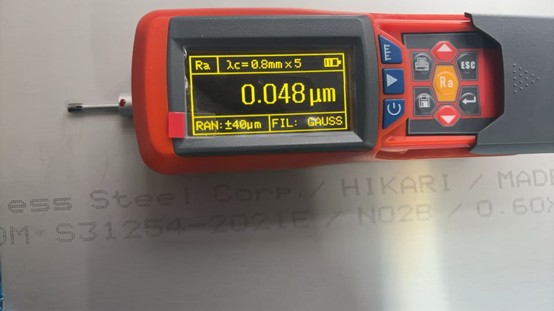Surface Roughness of Plates
Surface roughness refers to the microscopic irregularities on the surface of a plate. It is a key indicator of surface quality and plays a crucial role in determining the plate’s performance and suitability for further processing or end-use applications. Below are detailed insights into this important property:
Evaluation Parameters
Arithmetic Average Roughness (Ra): Ra is the arithmetic mean of the absolute values of the surface height deviations measured within a sampling length. As the most widely used roughness parameter, Ra provides a general measure of the surface profile. For example, general machined plates typically have an Ra of 1.6–6.3 μm, while finely ground or polished plates can reach as low as 0.1–0.8 μm.
Ten-Point Height (Rz): Rz represents the sum of the average height of the five highest surface peaks and the average depth of the five deepest valleys within a sampling length. It offers a more intuitive sense of the surface’s peak-valley characteristics and is often used in applications requiring high surface contact stiffness or wear resistance. For instance, wear-resistant plates are typically required to maintain Rz values within a specific range to ensure optimal durability.
Maximum Height (Ry): Ry measures the vertical distance between the highest peak and the lowest valley within a sampling length. It reflects the maximum fluctuation in surface profile and is an important reference when stress concentration and mechanical integrity under load are critical considerations.

Influencing Factors
Material Properties: The intrinsic characteristics of the plate material affect surface roughness. For example, stainless steel, known for its uniform texture and higher hardness, generally achieves lower roughness after machining compared to softer materials.
Manufacturing Process: The production method significantly impacts surface finish. Plates produced through rolling often exhibit higher roughness, whereas those finished with grinding or polishing show significantly smoother surfaces. Parameters such as cutting speed, tool wear, and feed rate also influence the final surface texture.
Surface Treatments: Post-processing techniques like coating, electroplating, or chemical deposition can alter the surface profile. These treatments typically create a uniform layer on the plate surface, improving smoothness and lowering roughness values.
Measurement Methods
Contact Stylus Method: A diamond-tipped stylus gently traces the plate surface, and vertical displacements are recorded to compute surface roughness. This method provides high precision and supports a range of roughness parameters but is slower and may cause slight surface scratches.
Optical Cutting Method (Light Section): A parallel light beam is projected at a fixed angle onto the surface, and reflected light is analyzed to determine the surface contour. This non-contact technique avoids damage but may be sensitive to optical system calibration and light source stability.
Interferometry: Using light interference, this method splits a beam—one part illuminates the test surface and the other serves as a reference. The resulting interference fringes reveal microscopic variations, offering extremely high precision. However, it requires sophisticated equipment and a controlled environment.

